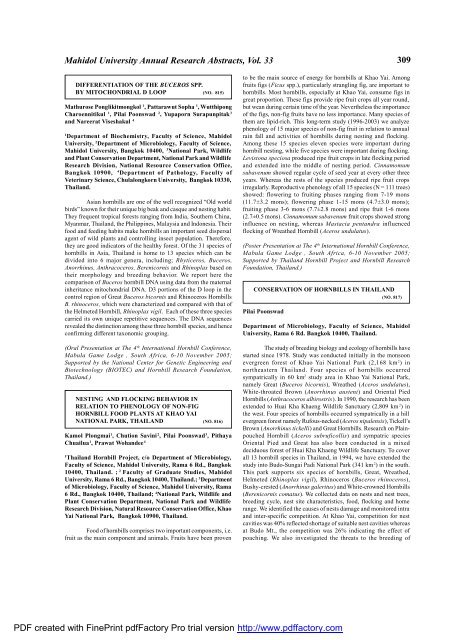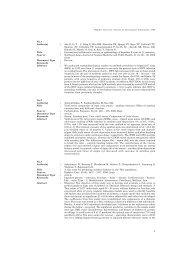Faculty of Science - Mahidol University
Faculty of Science - Mahidol University
Faculty of Science - Mahidol University
Create successful ePaper yourself
Turn your PDF publications into a flip-book with our unique Google optimized e-Paper software.
<strong>Mahidol</strong> <strong>University</strong> Annual Research Abstracts, Vol. 33 309<br />
DIFFERENTIATION OF THE BUCEROS SPP.<br />
BY MITOCHONDRIAL D LOOP (NO. 815)<br />
Mathurose Ponglikitmongkol 1 , Pattarawut Sopha 1 , Wutthipong<br />
Charoennitikul 1 , Pilai Poonswad 2 , Yupaporn Surapunpitak 3<br />
and Nareerat Viseshakul 4<br />
1 Department <strong>of</strong> Biochemistry, <strong>Faculty</strong> <strong>of</strong> <strong>Science</strong>, <strong>Mahidol</strong><br />
<strong>University</strong>, 2 Department <strong>of</strong> Microbiology, <strong>Faculty</strong> <strong>of</strong> <strong>Science</strong>,<br />
<strong>Mahidol</strong> <strong>University</strong>, Bangkok 10400, 3 National Park, Wildlife<br />
and Plant Conservation Department, National Park and Wildlife<br />
Research Division, National Resource Conservation Office,<br />
Bangkok 10900, 4 Department <strong>of</strong> Pathology, <strong>Faculty</strong> <strong>of</strong><br />
Veterinary <strong>Science</strong>, Chulalongkorn <strong>University</strong>, Bangkok 10330,<br />
Thailand.<br />
Asian hornbills are one <strong>of</strong> the well recognized “Old world<br />
birds” known for their unique big beak and casque and nesting habit.<br />
They frequent tropical forests ranging from India, Southern China,<br />
Myanmar, Thailand, the Philippines, Malaysia and Indonesia. Their<br />
food and feeding habits make hornbills an important seed dispersal<br />
agent <strong>of</strong> wild plants and controlling insect population. Therefore,<br />
they are good indicators <strong>of</strong> the healthy forest. Of the 31 species <strong>of</strong><br />
hornbills in Asia, Thailand is home to 13 species which can be<br />
divided into 6 major genera, including; Rhyticeros, Buceros,<br />
Anorrhinus, Anthracoceros, Berenicornis and Rhinoplax based on<br />
their morphology and breeding behavior. We report here the<br />
comparison <strong>of</strong> Buceros hornbill DNA using data from the maternal<br />
inheritance mitochondrial DNA. D3 portions <strong>of</strong> the D loop in the<br />
control region <strong>of</strong> Great Buceros bicornis and Rhinoceros Hornbills<br />
B. rhinoceros, which were characterized and compared with that <strong>of</strong><br />
the Helmeted Hornbill, Rhinoplax vigil. Each <strong>of</strong> these three species<br />
carried its own unique repetitive sequences. The DNA sequences<br />
revealed the distinction among these three hornbill species, and hence<br />
confirming different taxonomic grouping.<br />
(Oral Presentation at The 4 th International Hornbill Conference,<br />
Mabula Game Lodge , South Africa, 6-10 November 2005;<br />
Supported by the National Center for Genetic Engineering and<br />
Biotechnology (BIOTEC) and Hornbill Research Foundation,<br />
Thailand.)<br />
NESTING AND FLOCKING BEHAVIOR IN<br />
RELATION TO PHENOLOGY OF NON-FIG<br />
HORNBILL FOOD PLANTS AT KHAO YAI<br />
NATIONAL PARK, THAILAND (NO. 816)<br />
Kamol Plongmai 1 , Chution Savini 2 , Pilai Poonswad 3 , Pithaya<br />
Chuailua 1 , Prawat Wohandee 4<br />
1 Thailand Hornbill Project, c/o Department <strong>of</strong> Microbiology,<br />
<strong>Faculty</strong> <strong>of</strong> <strong>Science</strong>, <strong>Mahidol</strong> <strong>University</strong>, Rama 6 Rd., Bangkok<br />
10400, Thailand. ; 2 <strong>Faculty</strong> <strong>of</strong> Graduate Studies, <strong>Mahidol</strong><br />
<strong>University</strong>, Rama 6 Rd., Bangkok 10400, Thailand.; 3 Department<br />
<strong>of</strong> Microbiology, <strong>Faculty</strong> <strong>of</strong> <strong>Science</strong>, <strong>Mahidol</strong> <strong>University</strong>, Rama<br />
6 Rd., Bangkok 10400, Thailand; 4 National Park, Wildlife and<br />
Plant Conservation Department, National Park and Wildlife<br />
Research Division, Natural Resource Conservation Office, Khao<br />
Yai National Park, Bangkok 10900, Thailand.<br />
Food <strong>of</strong> hornbills comprises two important components, i.e.<br />
fruit as the main component and animals. Fruits have been proven<br />
to be the main source <strong>of</strong> energy for hornbills at Khao Yai. Among<br />
fruits figs (Ficus spp.), particularly strangling fig, are important to<br />
hornbills. Most hornbills, especially at Khao Yai, consume figs in<br />
great proportion. These figs provide ripe fruit crops all year round,<br />
but wean during certain time <strong>of</strong> the year. Nevertheless the importance<br />
<strong>of</strong> the figs, non-fig fruits have no less importance. Many species <strong>of</strong><br />
them are lipid-rich. This long-term study (1996-2003) we analyze<br />
phenology <strong>of</strong> 15 major species <strong>of</strong> non-fig fruit in relation to annual<br />
rain fall and activities <strong>of</strong> hornbills during nesting and flocking.<br />
Among these 15 species eleven species were important during<br />
hornbill nesting, while five species were important during flocking.<br />
Levistona speciosa produced ripe fruit crops in late flocking period<br />
and extended into the middle <strong>of</strong> nesting period. Cinnamomum<br />
subavenum showed regular cycle <strong>of</strong> seed year at every other three<br />
years. Whereas the rests <strong>of</strong> the species produced ripe fruit crops<br />
irregularly. Reproductive phenology <strong>of</strong> all 15 species (N = 111 trees)<br />
showed: flowering to fruiting phases ranging from 7-19 mons<br />
(11.7±3.2 mons); flowering phase 1-15 mons (4.7±3.0 mons);<br />
fruiting phase 3-6 mons (7.7±2.8 mons) and ripe fruit 1-6 mons<br />
(2.7±0.5 mons). Cinnamomum subavenum fruit crops showed strong<br />
influence on nesting, whereas Mastacia pentandra influenced<br />
flocking <strong>of</strong> Wreathed Hornbill (Aceros undulatus).<br />
(Poster Presentation at The 4 th International Hornbill Conference,<br />
Mabula Game Lodge , South Africa, 6-10 November 2005;<br />
Supported by Thailand Hornbill Project and Hornbill Research<br />
Foundation, Thailand.)<br />
CONSERVATION OF HORNBILLS IN THAILAND<br />
Pilai Poonswad<br />
(NO. 817)<br />
Department <strong>of</strong> Microbiology, <strong>Faculty</strong> <strong>of</strong> <strong>Science</strong>, <strong>Mahidol</strong><br />
<strong>University</strong>, Rama 6 Rd. Bangkok 10400, Thailand.<br />
The study <strong>of</strong> breeding biology and ecology <strong>of</strong> hornbills have<br />
started since 1978. Study was conducted initially in the monsoon<br />
evergreen forest <strong>of</strong> Khao Yai National Park (2,168 km 2 ) in<br />
northeastern Thailand. Four species <strong>of</strong> hornbills occurred<br />
sympatrically in 60 km 2 study area in Khao Yai National Park,<br />
namely Great (Buceros bicornis), Wreathed (Aceros undulatus),<br />
White-throated Brown (Anorrhinus austeni) and Oriental Pied<br />
Hornbills (Anthracoceros albirostris). In 1990, the research has been<br />
extended to Huai Kha Khaeng Wildlife Sanctuary (2,809 km 2 ) in<br />
the west. Four species <strong>of</strong> hornbills occurred sympatrically in a hill<br />
evergreen forest namely Rufous-necked (Aceros nipalensis), Tickell’s<br />
Brown (Anorrhinus tickelli) and Great Hornbills. Research on Plainpouched<br />
Hornbill (Aceros subruficollis) and sympatric species<br />
Oriental Pied and Great has also been conducted in a mixed<br />
deciduous forest <strong>of</strong> Huai Kha Khaeng Wildlife Sanctuary. To cover<br />
all 13 hornbill species in Thailand, in 1994, we have extended the<br />
study into Budo-Sungai Padi National Park (341 km 2 ) in the south.<br />
This park supports six species <strong>of</strong> hornbills, Great, Wreathed,<br />
Helmeted (Rhinoplax vigil), Rhinoceros (Buceros rhinoceros),<br />
Bushy-crested (Anorrhinus galeritus) and White-crowned Hornbills<br />
(Berenicornis comatus). We collected data on nests and nest trees,<br />
breeding cycle, nest site characteristics, food, flocking and home<br />
range. We identified the causes <strong>of</strong> nests damage and monitored intra<br />
and inter-specific competition. At Khao Yai, competition for nest<br />
cavities was 40% reflected shortage <strong>of</strong> suitable nest cavities whereas<br />
at Budo Mt., the competition was 26% indicating the effect <strong>of</strong><br />
poaching. We also investigated the threats to the breeding <strong>of</strong><br />
PDF created with FinePrint pdfFactory Pro trial version http://www.pdffactory.com
















